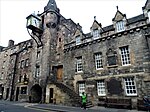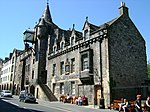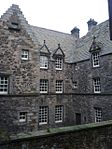Canongate Kirkyard
1680s establishments in ScotlandAll accuracy disputesBurials at the Canongate KirkyardCemeteries in ScotlandChurches in Edinburgh ... and 3 more
Kirkyards in ScotlandRoyal MileUse British English from March 2017

The Canongate Kirkyard (English: Churchyard) stands around Canongate Kirk on the Royal Mile in Edinburgh, Scotland. The churchyard was used for burials from the late 1680s until the mid-20th century. The most celebrated burials at the kirkyard are the economist Adam Smith and the poet Robert Fergusson, but many other notable people were interred in the cemetery. It has been claimed that David Rizzio, the murdered private secretary of Mary, Queen of Scots, lies here, although it is highly unlikely that an Italian Catholic would be reinterred in a Protestant graveyard 120 years after his death.
Excerpt from the Wikipedia article Canongate Kirkyard (License: CC BY-SA 3.0, Authors, Images).Canongate Kirkyard
Old Tolbooth Wynd, City of Edinburgh Canongate
Geographical coordinates (GPS) Address External links Nearby Places Show on map
Geographical coordinates (GPS)
| Latitude | Longitude |
|---|---|
| N 55.95225 ° | E -3.17984 ° |
Address
Canongate Kirkyard (Marchmont Burial Ground)
Old Tolbooth Wynd
EH8 8BN City of Edinburgh, Canongate
Scotland, United Kingdom
Open on Google Maps











